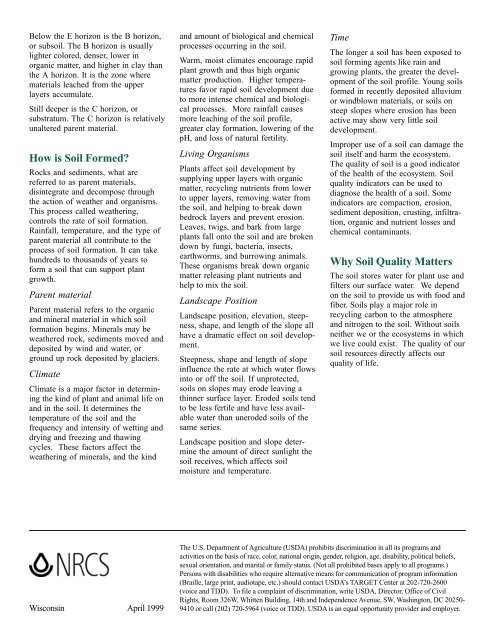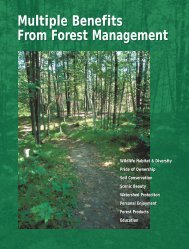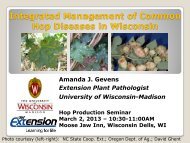Antigo Silt Loam
Wisconsin State Soil: Antigo Silt Loam - US Department of Agriculture
Wisconsin State Soil: Antigo Silt Loam - US Department of Agriculture
- No tags were found...
You also want an ePaper? Increase the reach of your titles
YUMPU automatically turns print PDFs into web optimized ePapers that Google loves.
Below the E horizon is the B horizon,<br />
or subsoil. The B horizon is usually<br />
lighter colored, denser, lower in<br />
organic matter, and higher in clay than<br />
the A horizon. It is the zone where<br />
materials leached from the upper<br />
layers accumulate.<br />
Still deeper is the C horizon, or<br />
substratum. The C horizon is relatively<br />
unaltered parent material.<br />
How is Soil Formed?<br />
Rocks and sediments, what are<br />
referred to as parent materials,<br />
disintegrate and decompose through<br />
the action of weather and organisms.<br />
This process called weathering,<br />
controls the rate of soil formation.<br />
Rainfall, temperature, and the type of<br />
parent material all contribute to the<br />
process of soil formation. It can take<br />
hundreds to thousands of years to<br />
form a soil that can support plant<br />
growth.<br />
Parent material<br />
Parent material refers to the organic<br />
and mineral material in which soil<br />
formation begins. Minerals may be<br />
weathered rock, sediments moved and<br />
deposited by wind and water, or<br />
ground up rock deposited by glaciers.<br />
Climate<br />
Climate is a major factor in determining<br />
the kind of plant and animal life on<br />
and in the soil. It determines the<br />
temperature of the soil and the<br />
frequency and intensity of wetting and<br />
drying and freezing and thawing<br />
cycles. These factors affect the<br />
weathering of minerals, and the kind<br />
and amount of biological and chemical<br />
processes occurring in the soil.<br />
Warm, moist climates encourage rapid<br />
plant growth and thus high organic<br />
matter production. Higher temperatures<br />
favor rapid soil development due<br />
to more intense chemical and biological<br />
processes. More rainfall causes<br />
more leaching of the soil profile,<br />
greater clay formation, lowering of the<br />
pH, and loss of natural fertility.<br />
Living Organisms<br />
Plants affect soil development by<br />
supplying upper layers with organic<br />
matter, recycling nutrients from lower<br />
to upper layers, removing water from<br />
the soil, and helping to break down<br />
bedrock layers and prevent erosion.<br />
Leaves, twigs, and bark from large<br />
plants fall onto the soil and are broken<br />
down by fungi, bacteria, insects,<br />
earthworms, and burrowing animals.<br />
These organisms break down organic<br />
matter releasing plant nutrients and<br />
help to mix the soil.<br />
Landscape Position<br />
Landscape position, elevation, steepness,<br />
shape, and length of the slope all<br />
have a dramatic effect on soil development.<br />
Steepness, shape and length of slope<br />
influence the rate at which water flows<br />
into or off the soil. If unprotected,<br />
soils on slopes may erode leaving a<br />
thinner surface layer. Eroded soils tend<br />
to be less fertile and have less available<br />
water than uneroded soils of the<br />
same series.<br />
Landscape position and slope determine<br />
the amount of direct sunlight the<br />
soil receives, which affects soil<br />
moisture and temperature.<br />
Time<br />
The longer a soil has been exposed to<br />
soil forming agents like rain and<br />
growing plants, the greater the development<br />
of the soil profile. Young soils<br />
formed in recently deposited alluvium<br />
or windblown materials, or soils on<br />
steep slopes where erosion has been<br />
active may show very little soil<br />
development.<br />
Improper use of a soil can damage the<br />
soil itself and harm the ecosystem.<br />
The quality of soil is a good indicator<br />
of the health of the ecosystem. Soil<br />
quality indicators can be used to<br />
diagnose the health of a soil. Some<br />
indicators are compaction, erosion,<br />
sediment deposition, crusting, infiltration,<br />
organic and nutrient losses and<br />
chemical contaminants.<br />
Why Soil Quality Matters<br />
The soil stores water for plant use and<br />
filters our surface water. We depend<br />
on the soil to provide us with food and<br />
fiber. Soils play a major role in<br />
recycling carbon to the atmosphere<br />
and nitrogen to the soil. Without soils<br />
neither we or the ecosystems in which<br />
we live could exist. The quality of our<br />
soil resources directly affects our<br />
quality of life.<br />
Wisconsin April 1999<br />
The U.S. Department of Agriculture (USDA) prohibits discrimination in all its programs and<br />
activities on the basis of race, color, national origin, gender, religion, age, disability, political beliefs,<br />
sexual orientation, and marital or family status. (Not all prohibited bases apply to all programs.)<br />
Persons with disabilities who require alternative means for communication of program information<br />
(Braille, large print, audiotape, etc.) should contact USDA’s TARGET Center at 202-720-2600<br />
(voice and TDD). To file a complaint of discrimination, write USDA, Director, Office of Civil<br />
Rights, Room 326W, Whitten Building, 14th and Independence Avenue, SW, Washington, DC 20250-<br />
9410 or call (202) 720-5964 (voice or TDD). USDA is an equal opportunity provider and employer.








